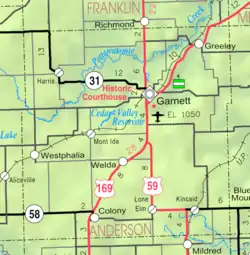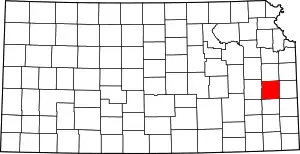Garnett, Kansas
Garnett is a city in and the county seat of Anderson County, Kansas, United States.[6] As of the 2010 census, the city population was 3,415.[7]
Garnett, Kansas | |
|---|---|
City and County seat | |
 Anderson County Courthouse (2009) | |
 Location within Anderson County and Kansas | |
 KDOT map of Anderson County (legend) | |
| Coordinates: 38°16′58″N 95°14′27″W | |
| Country | United States |
| State | Kansas |
| County | Anderson |
| Platted | 1857 |
| Incorporated | 1861 |
| Named for | W.A. Garnett |
| Area | |
| • Total | 3.19 sq mi (8.25 km2) |
| • Land | 3.08 sq mi (7.98 km2) |
| • Water | 0.10 sq mi (0.27 km2) |
| Elevation | 1,070 ft (330 m) |
| Population | |
| • Total | 3,415 |
| • Estimate (2019)[3] | 3,235 |
| • Density | 1,049.64/sq mi (405.22/km2) |
| Time zone | UTC-6 (CST) |
| • Summer (DST) | UTC-5 (CDT) |
| ZIP code | 66032 |
| Area code | 785 |
| FIPS code | 20-25925 [4] |
| GNIS ID | 0477665 [5] |
| Website | City website |
History
Garnett was platted in 1857.[8] Garnett is named for W. A. Garnett, a native of Louisville, Kentucky, and early promoter of the town of Garnett.[9][10]
The city includes three places listed on the National Register of Historic Places: Anderson County Courthouse, Sennett and Bertha Kirk House, and Shelley-Tipton House.
The city is also home to the 1858 Garnett House Hotel.
Geography
According to the United States Census Bureau, the city has a total area of 3.20 square miles (8.29 km2), of which 3.10 square miles (8.03 km2) is land and 0.10 square miles (0.26 km2) is water.[11]
Garnett is famous for its fossil finds from the late Carboniferous period. The lagerstätte is about 300 million years old and contains some of the earliest reptiles on earth.
Climate
The climate in this area is characterized by hot, humid summers and generally mild to cool winters. According to the Köppen Climate Classification system, Garnett has a humid subtropical climate, abbreviated "Cfa" on climate maps.[12]
Demographics
| Historical population | |||
|---|---|---|---|
| Census | Pop. | %± | |
| 1870 | 1,219 | — | |
| 1880 | 1,389 | 13.9% | |
| 1890 | 2,191 | 57.7% | |
| 1900 | 2,078 | −5.2% | |
| 1910 | 2,334 | 12.3% | |
| 1920 | 2,329 | −0.2% | |
| 1930 | 2,768 | 18.8% | |
| 1940 | 2,607 | −5.8% | |
| 1950 | 2,693 | 3.3% | |
| 1960 | 3,034 | 12.7% | |
| 1970 | 3,169 | 4.4% | |
| 1980 | 3,310 | 4.4% | |
| 1990 | 3,210 | −3.0% | |
| 2000 | 3,368 | 4.9% | |
| 2010 | 3,415 | 1.4% | |
| 2019 (est.) | 3,235 | [3] | −5.3% |
| U.S. Decennial Census[13] | |||
.jpg.webp)
2010 census
As of the census[2] of 2010, there were 3,415 people, 1,419 households, and 862 families living in the city. The population density was 1,101.6 inhabitants per square mile (425.3/km2). There were 1,591 housing units at an average density of 513.2 per square mile (198.1/km2). The racial makeup of the city was 96.7% White, 0.4% African American, 0.6% Native American, 0.5% Asian, 0.6% from other races, and 1.3% from two or more races. Hispanic or Latino of any race were 2.1% of the population.
There were 1,419 households, of which 30.0% had children under the age of 18 living with them, 45.5% were married couples living together, 10.4% had a female householder with no husband present, 4.9% had a male householder with no wife present, and 39.3% were non-families. 34.0% of all households were made up of individuals, and 19.4% had someone living alone who was 65 years of age or older. The average household size was 2.33 and the average family size was 2.98.
The median age in the city was 40.9 years. 25.1% of residents were under the age of 18; 7.7% were between the ages of 18 and 24; 21.7% were from 25 to 44; 23% were from 45 to 64; and 22.5% were 65 years of age or older. The gender makeup of the city was 47.9% male and 52.1% female.
2000 census
As of the census[4] of 2000, there were 3,368 people, 1,439 households, and 886 families living in the city. The population density was 1,124.6 people per square mile (434.9/km2). There were 1,597 housing units at an average density of 533.2 per square mile (206.2/km2). The racial makeup of the city was 96.97% White, 0.39% African American, 1.04% Native American, 0.27% Asian, 0.06% Pacific Islander, 0.53% from other races, and 0.74% from two or more races. Hispanic or Latino of any race were 1.45% of the population.
There were 1,439 households, out of which 28.8% had children under the age of 18 living with them, 50.2% were married couples living together, 8.5% had a female householder with no husband present, and 38.4% were non-families. 34.7% of all households were made up of individuals, and 21.1% had someone living alone who was 65 years of age or older. The average household size was 2.25 and the average family size was 2.91.
In the city, the population was spread out, with 24.4% under the age of 18, 7.5% from 18 to 24, 23.3% from 25 to 44, 20.7% from 45 to 64, and 24.1% who were 65 years of age or older. The median age was 41 years. For every 100 females, there were 88.2 males. For every 100 females age 18 and over, there were 82.1 males.
The median income for a household in the city was $31,518, and the median income for a family was $38,095. Males had a median income of $31,175 versus $19,858 for females. The per capita income for the city was $16,265. About 9.2% of families and 13.0% of the population were below the poverty line, including 18.6% of those under age 18 and 9.9% of those age 65 or over.
Education
Unified School District No. 365 operates Garnett Elementary School and Anderson County Junior-Senior High School in Garnett.[14]
Prior to school unification, the Garnett High School mascot was Bulldogs. The Anderson County High School mascot is also Bulldogs.[15]
Infrastructure
Rail
The area has one railroad, six freight lines and six interstate carriers.
Roads
Garnett is at the crossroads of U.S. Route 59, U.S. Route 169 and K-31. Interstate 35 is located 19 miles north of here and Interstate 70 is approximately 50 miles away.
Air
The Garnett Industrial Airport is located along U.S. 169. The nearest international air service is at the Kansas City International Airport, 90 miles away.
Bike
There is a bike path at Prairie Spirit Trail State Park.
Notable people
- Sam Brownback, incumbent United States Ambassador-at-Large for International Religious Freedom, former Governor of Kansas and former member of Congress
- Arthur Capper, former Governor of Kansas and US Senator
- Edgar Masters, poet, lawyer and playwright
- P. Thomas Thornbrugh, currently a judge on the Oklahoma Civil Appeals Court, was born in Garnett
Further reading
References
- "2019 U.S. Gazetteer Files". United States Census Bureau. Retrieved July 24, 2020.
- "U.S. Census website". United States Census Bureau. Retrieved 2012-07-06.
- "Population and Housing Unit Estimates". United States Census Bureau. May 24, 2020. Retrieved May 27, 2020.
- "U.S. Census website". United States Census Bureau. Retrieved 2008-01-31.
- "US Board on Geographic Names". United States Geological Survey. 2007-10-25. Retrieved 2008-01-31.
- "Find a County". National Association of Counties. Archived from the original on 2011-05-31. Retrieved 2011-06-07.
- "2010 City Population and Housing Occupancy Status". U.S. Census Bureau. Retrieved March 6, 2011.
- Blackmar, Frank Wilson (1912). Kansas: A Cyclopedia of State History, Embracing Events, Institutions, Industries, Counties, Cities, Towns, Prominent Persons, Etc. Standard Publishing Company. pp. 712.
- Gannett, Henry (1905). The Origin of Certain Place Names in the United States. Govt. Print. Off. pp. 135.
- "Profile for Garnett, Kansas". ePodunk. Retrieved 29 June 2014.
- "US Gazetteer files 2010". United States Census Bureau. Archived from the original on 2012-07-02. Retrieved 2012-07-06.
- Climate Summary for Garnett, Kansas
- United States Census Bureau. "Census of Population and Housing". Retrieved September 4, 2014.
- "School Campuses." Unified School District No. 365. Retrieved on November 8, 2013.
- "Garnett Bulldogs Defeat Fredonia", The Ottawa Herald, 7 January 1959, p.3.
External links
| Wikimedia Commons has media related to Garnett, Kansas. |
